
|
|
Cybersix
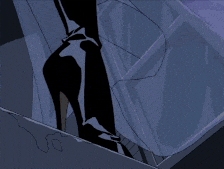 Cybersix is like the King's X of animation. If you know of the band, they're probably one of the coolest bands you've ever heard. But most people have just never heard of them. Honestly? I don't think "perfection" is a thing that truly exists. But if I were to measure a show simply by the culmination of its individual elements on a scale of how much I personally enjoy them, then yeah, I would say Cybersix is about as close to perfection as can be achieved. Sporting a delicious blend of flavors taken from the recipe books of caped crusaders, film noir, golden age sci-fi comics, 90s punk counter-culture, and what we now refer to as "retro anime", Cybersix is simultaneously all of these things, and yet somehow none of them at all, operating on a completely different sub-level all its own. It's a unique concoction of stackable influences, perfectly complemented by its subtle and often unspoken world-building, and its aura of mystery and frequent lack of explanation makes it the type of show that rewards patience and willfully investing one's attention. The best way I can sum up the series conceptually is: "A gender-bending cyborg and her companions - a black panther and a high school science teacher - are relentlessly attacked by the son of a Nazi scientist and an endless menagerie of B-movie monsters as they terrorize a big city somewhere in South America." And although that synopsis does rely on some extrapolation and just a bit of hyperbole, it also doesn't quite do justice to the vibe that Cybersix embodies, which is what truly sets it apart as an amazing show.
 The prophecies were true. Geeks inherited the earth, then proceeded to turn everyone beneath them into mindless zombie drones. Before I dive into the show itself, let me set the stage for a moment. The mid 90s and early 00s were an absolutely buck wild time for animation. TV networks and production studios had started moving away from the safety and predictability of syndicated programming and toyetic action cartoons aimed at young boys and girls (on the off chance that they remembered girls existed), and started experimenting with edgier, often more mature formats, looking to connect with untapped demographics like teens and young adults. While MTV and anime blocks like Toonami and Sci-Fi's "anime Saturday" (later "Animonday") are widely recognized as the superstars leading that charge, many people often forget or overlook the contribution of Canadian productions of that era. More commonly known for its kid-friendly networks like Nelvana and YTV, the Canadian animation scene is - speaking as an American - a strange and interesting land to explore. In my early teens, I lived near the border and, thanks to the magic of analog TV stations, found myself watching shows that no one really remembers. Looking back, it almost feels like a Mandela-affected alternate reality. Sure, Canadian cartoons have occasionally found moderate success in America - Sam & Max, Total Drama, and ReBoot to name a few - but in every case, there's always a certain je ne sais quois about them that invisibly sets them apart from their American contemporaries.
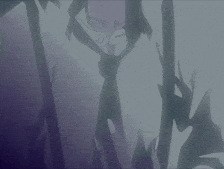 If this is the "safe for broadcast" version, imagine how deliciously sensual this scene could have been in its original adult context. This may be because Canadian productions have always been closer-knit with the European scene - fairly common knowledge, but European cartoons have always been leaps and bounds ahead of American ones in terms of pushing boundaries - but over the years I've frequently found Canadian shows to be a real dragon's horde of hidden gems in the animation world. Compared to the American scene, still trapped by the bounds of angry conservative parents complaining about Spongebob sounding too effeminate or The Powerpuff Girls featuring a cross-dressing demon for a villain, Canadian cartoons seemed to breeze right past them into such forbidden topics as homosexuality and boob jokes in their Y7 and PG cartoons. It's absolutely mind-boggling to look back on that time to see how much (or how little) we Americans have progressed in the past 20 years. As I'll be demonstrating in this review, Cybersix is a show that may well enough still qualify as a Y7 series in most respects, but seeing as its main cast are mostly adults, the plot is rarely explained in any significant detail, and the overall color palette is muted and brooding, it tracks that the show would be far more popular with an older audience. Even moreso when you start examining its more progressive and nuanced mature themes.
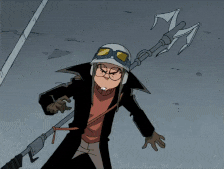 I used to think this guy was some kind of unfortunate racial stereotype token character until I learned that the world's largest population of Japanese people living outside of Japan are actually residing in Brazil. The more you know! Airing for a single season of 13 episodes, Cybersix is loosely adapted from an Argentinian comic aimed at the counter-culture young adult audience. Even in animated series form, it seeks to walk that fine line between target ages, offering up that delicious monster-of-the-week action we all know and love, but wrapped in a layer of neo-noir mystery. Much like its rebellious 90s peers, the show rejects the traditional superhero or shounen format, relying instead on complex and troubled characters whose goals and motives are sometimes unclear. The titular Cybersix is an escaped human-cyborg experiment, currently living a double life as both a costumed crime fighter and a demure high school literature teacher. Keeping her finger on the pulse of the city ("Meridiana" by name, which I've chosen to assume is loosely based on a big city like Buenos Aires or Sao Paulo), she's taken a vested interest in keeping the rampant organized crime wave and monster attacks in check, but silently and anonymously, if possible. Aside from having a secret identity to protect, both she and the monsters share their origins as creations of a mad scientist, and can only survive by consuming a strange chemical substance only he knows how to synthesize. Thus, her true calling for taking up the mantle isn't born of justice - though she does care about protecting innocent lives - but rather, a need to absorb the monsters' life forces like a leather-clad vampire.
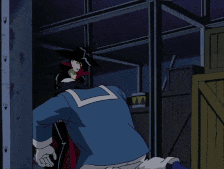 Even if it isn't explicit, the show clearly isn't afraid of being what it is, and it's not hard to guess what happens off-screen. But the real kicker here is that Cybersix effortlessly switches genders when going from personality A to B, making her hard to track down, and even harder to maintain a relationship with. Taking the moniker "Adrian Seidelman" by day, our half-human hero successfully blends in with the city folk and lives both his & her lives on the edge, deftly juggling allies and enemies in a bid to keep her alter egos closely guarded. Looking back, it's hard to imagine by present-day standards, but there really was a time (not even that long ago!) when this sort of thing was still entirely possible, long before the age of data collection and social media and algorithmic facial recognition. That sort of nostalgic escapism makes up a huge portion of the show's charm for me as a genderqueer person. And despite running for only a single season with little overarching plot to speak of, the intrigue surrounding Cybersix and Adrian's dual lives provides a lot of unspoken storytelling that more than makes up for a lack of plot. Frequently referred to by enemies as the "renegade cyber", plus the fact that Cybersix and Adrian rarely ever seem to sleep, it's immediately clear that they are much more a synthetic being than a human one, same as the hulking zombie-like goons accompanying the villains. Considering that the brutes are explicitly called "Fixed Ideas", and that the evil doctor muses on Cybersix as his "greatest failure", the details surrounding her backstory are never spelled out in plain English*, but the clues are all there for you to pick up and form your own conclusions, giving the series plenty of rewatch potential. *Yes honey, I know the explanation is all there in the original comic series. I know. But we're talking about the cartoon here, so let's pretend for the sake of this review that the comic is an entirely separate entity. 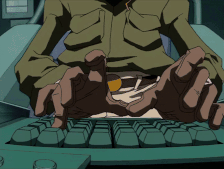 The dream of changing your face, hopping on a bus, and moving to a new city to start a new life without anyone knowing of your old identity is one shared by a great many of the genderqueer crowd. Circling back to the "hyperbole" bit at the beginning of the review, let's talk about the villains. It's never spoken aloud in the show itself, but it's strongly implied that the mad scientist (von Richter) and his son José are indeed Nazis. Aside from having a stereotypical German name, Richter's medical experimentation harkens back to the inhumane atrocities committed by the Nazi regime in their quest to create "racially pure" super-soldiers (again, the name "Fixed Ideas" carries some hefty connotations). Further evidence can be found in José's "Hitler youth" outfit, as well as his otherwise inexplicable tendency to goose-step around while ruminating on his latest attempt to take over the city or capture Cybersix. Richter himself serves as more of a background character than his son, occasionally appearing on video chat to either brief José on the latest monster to join their army, or to scold him for his failure. This makes José the primary antagonist of the show, a Mandark-like evil child genius who - despite his evil Nazi upbringing - is still a child, easily distracted and prone to immature temper tantrums. In many ways, José's incompetence unexpectedly provides the show's comic relief. And although the show's original source material veers into much darker territory, I kind of prefer this approach, as the Nazis were famously inhumane, yes, but also famously inept at their jobs. It's not okay to joke about the Holocaust, but it IS okay to laugh at bigots' idiocy and belittle them, empowering us to de-legitimize them politically.
 Compared to other cape-and-cowl action shows, villains of José's caliber are in...shall we say, short supply? Rounding out the show's cast is Adrian's fellow teacher and lunch buddy, Lucas. A big strong teddy bear who teaches science and loves sports, Lucas does his best to make Adrian feel welcome at the school, and regularly hangs out with him after work. Predictably, this means he also finds himself mixed up in Cybersix's web as well, unleashing his inner hard-boiled and reckless action detective to help her fend off foes and keep their students out of harm's way. And as if that weren't complicated enough, he also ends up developing feelings for her, blissfully unaware that she and Adrian are the same person. In any other production, the No Homo angle would have been milked to high heaven for "comedic" effect, but here it's played surprisingly (heh) straight. Lucas cares deeply about his friendship with Adrian, even when Adrian cryptically warns him not to get involved or randomly disappears without explanation. Even moreso, Lucas finds himself worrying not about what kind of trouble HE will get into by sticking around this enigmatic lady of the night and her kinky-costumed antics, but rather if Cybersix herself will be okay. Himbo to the core, Lucas is willing to rush headlong to her rescue at the drop of her extremely cool wide-brimmed fedora, and a slow burn romance builds up between them over the course of the show. And let's just say - to spoil the ending a bit - it does end in a VERY satisfying way.
 There is an incredible tenderness and sensuality to the way the romance is depicted, especially evident in the way it makes even big men like Lucas seem soft and fragile at times. Of course, the additional layer of implied bisexuality helps, too. I really love that Cybersix continues the tradition of pairing gender fluidity with ethereal mystery. Historically, "normies" have always found queer and nonbinary people to be captivating and enigmatic - there's a reason that angels and aliens are so commonly depicted as androgynous - and it tracks, since most genderqueer people enjoy existing outside of the box to begin with. What makes Cybersix special in this regard is that it asserts its themes of genderfuckery in spite of the notoriously and overwhelmingly heterosexual world of science fiction. In a genre regularly staffed by Rick Deckards and Han Solos, we could really use more gender-swapping leads who embody that spirit of secrecy and intrigue that powers all sci-fi/noir hybrids to begin with. And that's not to even mention the inherent queerness of Lucas falling for Cybersix, even after the stirring finale suggests he knows that she and Adrian are one and the same. We need so much more of this in sci-fi. It's a perfect genre for exploring sexuality and our relationship with gender, and it's incredibly frustrating when queer stories never get the coverage or critical acclaim that they deserve. More like this, please!
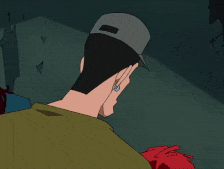 The amount of personality in the show's animation is phenomenal, especially in scenes that are otherwise inconsequential to the bigger story. Alright, moving on. Generally when writing these reviews, I like to do a little research on the production history of each show. The company responsible in Cybersix's case was Vancouver-based Network of Animation (billed as "NoA" - and not to be confused with Japanese animation Studio NOA), and I wish I could find more information about them as a company. They are listed here and there on the internet as having done various layout and pre-production work for some big name cartoons (the '93 version of Pink Panther, a few episodes of Batman: The Animated Series, Beetlejuice, and Billy The Cat), but they seem to have unceremoniously vanished off the radar entirely in the early 00s, and it's hard to find much mention of them online outside of their work on Cybersix specifically. Even stranger, NoA wasn't officially dissolved until May of 2024, which suggests to me they definitely went under after their massive undertaking funding Cybersix, and must have survived in name alone on meager royalties over the years since then. Various interview tidbits suggest that the show was very expensive, even in its own time, and although the end result is downright gorgeous, if a show doesn't become an immediate breakout hit overnight, the studios involved will simply not have the cash flow to keep it going for another season. The data is scarce, but the clues all line up to me: Cybersix must have been the bomb that tanked NoA.
 If you're gonna bet it all, you'd damn well better make sure it's gonna hit. Then again, looking at even a minute of footage from the show should immediately make it clear why it was so expensive. The animation was headed by legendary Japanese animation studio TMS (known for various incarnations of Lupin III, Little Nemo: Adventures In Slumberland, and motherfucking AKIRA), and it really looks like they went all out with it. Combining the best of anime flips and kicks with the stylish Batman-esque flowing cape action, the show radiates a natural liveliness in every moment, almost cinematic in comparison to other anime of the time. Shadows and mood lighting are also used to their full extent, with animators frequently "bumping the lamp" to really nail that noir aesthetic in the most impressive and costly way possible. Even the smaller moments like Adrian and Lucas arguing over lunch at the diner are fueled by emotive and expressive body language, taking full advantage of the show's propensity for character-driven interactions. Even when the plot elements are light or unexplored, the show-don't-tell visual style of the show communicates volumes on its own.
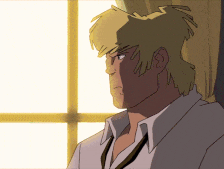 I consider myself bisexual with a preference for women, but Lucas is absolutely my kind of guy. And it's that character-driven focus that really forms the series' foundation. While understanding how a fictional world functions mechanically is the crucial "science" part of science fiction, it's always the characters and the way they interact within that world that powers the story. Sure, Cybersix has a system in place that its cyborgs and monsters must adhere to, but the meat of the story comes from the choices they make in the life they are dealt. Many of the monsters and contracted bounty hunters are not inherently evil, and the way each encounter plays out depends heavily on their own personality. In many cases, the monsters learn to recognize that Cybersix is like a sibling to them, a fellow undesired result of a cruel lab experiment who didn't ask to be what they are. You can see a certain innocence or brainwashed naivety in they way they fight, or that moment of realization when they understand that Cybersix is not only more powerful than they are, but might even be able to fight back against their creator and free them all from this nightmare of an existence. A lot of modern cyberpunk stories seem too focused on out-grimming each other or being seen as "clever", and fail to connect on an emotional or heartfelt level, but even if the PG nature of the show sometimes prevents it from being the best it can possibly be, Cybersix's character-first approach still hits just the same, and often puts its other sci-fi peers to shame as a result.
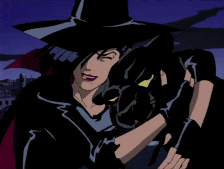 Did I mention that her animal companion is a fucking black panther? How much more badass can this show possibly be?! All that said, this is easily one of the coolest cartoons I've ever watched. Regardless of how much darker and edgier it *could* have been, the unspoken details of its world are as dark and edgy as they need to be, and the way the show leaves clues lying about for viewers to pick up on is a truly masterful way to reward eagle-eyed and willful participants. The animation is awe-inspiringly fluid and wholly unafraid to be cartoony, which - combined with its complex and troubled cast of adults - gives it that perfect balance of maturity and whimsy that I'm always pining for. Likewise, the show's themes of interrogating gender and sexuality, using your talents to help those around you that you can, and making fun of idiot Nazi children stand out to me as more potent than most so-called adult shows currently on the market. Wrapping this up in an irresistably cool Blade Runner or Dark City inspired aesthetic is just the cherry on top. There is simply nothing I dislike about this show!
 Look at this dumbass, hopping around like Yosemite Sam when he's angry. Everybody point and laugh at the dipshit Nazi! OKAY! It's time to make some follow-up recommendations! You'll be hard pressed to find another show quite like Cybersix, but a lesser-known anime I'd like to draw your attention to is Kurau: Phantom Memory. Drawing on similar elements of science fiction, mystery, and a bit of genderfuckery, Kurau is a slow burn story about a science experiment gone wrong that accidentally merges a human and an alien into a sort of psychic-sibling symbiotic relationship. In both shows, the larger picture is often much bigger than what you get to see on screen, and the actual episode-to-episode plot focuses more on their lives spent in between the bigger moments as the pair live on the run from a government organization determined to recapture them. It's cool stuff! For other shows that are stylistically similar to Cybersix, you can't go wrong with classics like Batman Beyond and The Big O. If you really enjoyed the cyborg/human angle, something like No Guns Life might also be up your alley. Or - and this is only because I think I'm being hilarious with this - here are a few other somewhat-similar titles that might appeal, all of which contain the word "phantom" in the title: Phantom 2040, Boogiepop Phantom, and Phantom: Requiem For The Phantom.
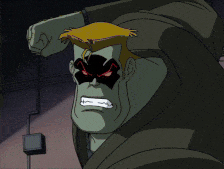 Okay, but like, just TRY to tell me I'm wrong when I describe Cybersix as "if Batman and Carmen Sandiego did the fusion dance together". What other wondrous and exciting old gems can I dig up for the next review? Only one way to find out, eh? Stay tuned for more!
|
|